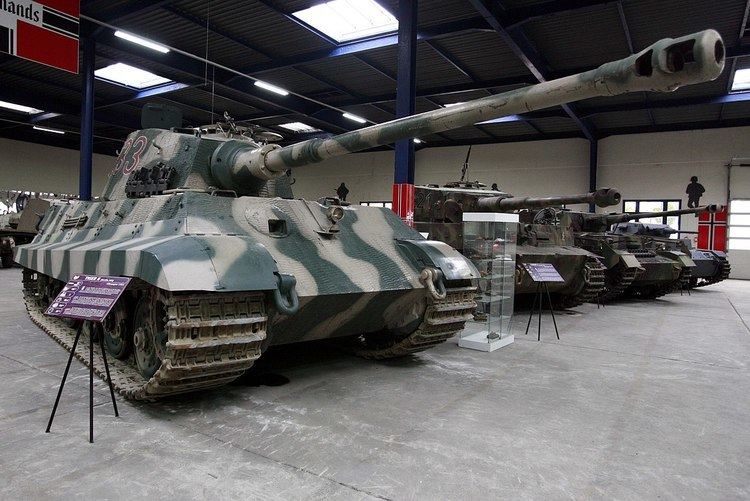 | ||
The 8.8 cm KwK 43 L/71 (Kampfwagenkanone —"fighting vehicle cannon") was an 88 mm 71 calibre tank gun designed by Krupp and used by the German Wehrmacht during the Second World War. It was mounted as the primary armament on the Panzerkampfwagen VI Ausf. B Tiger II and the 8.8 cm PaK 43, an anti-tank gun, was very similar in design and use albeit not mounted on tanks but rather on tank destroyers or deployed on the field.
Contents
Design and development
At 6.24 m (20.5 ft), the length of the KwK 43's barrel was over 1.3 metres longer than of that of the 8.8 cm KwK 36 L/56 used for the Tiger I. The cartridge of the KwK 43's shell was also considerably longer (at 82.2 cm) and wider than that of the KwK 36's meaning that the KwK 43 allows for more room for a heavier propellant charge in its shells than the KwK 36 could. All guns of the PaK/KwK 43 series could use the same ammunition interchangeably.
The KwK 43 and PaK 43 were initially manufactured with monobloc barrels meaning the barrel was made from one piece. However, due to the weapons' extremely high muzzle velocity and operating pressures when fired, the weapon suffered from accelerated barrel wear. As a result, the change was made to manufacture the PaK/KwK 43 with a two-piece barrel instead of a monobloc barrel. This had minimal to no effect on the performance of the gun, but made replacing a worn-out barrel much faster and easier than before.
In addition, the massively increased operating pressures of the new gun in turn required a new armour-piercing shell to be designed. The result of this was the PzGr.39/43 APCBC-HE projectile, which was similar to the older 10.2 kilograms PzGr.39-1 APCBC-HE projectile used by the 8.8 cm KwK 36 and PaK 43 guns except for the addition of much wider driving bands. The wider driving bands of the PzGr.39/43 increased the weight of the shell to 10.4 kilograms as a result. However, due to the full transition to the newer PzGr.39/43 rounds wasn't completed for some time, the older PzGr.39-1 rounds was instead allowed to be used for the KwK 43 & PaK 43 if provided the gun had fired no more than 500 rounds. Over that set amount, it was feared that the expected barrel wear combined with the narrower driving bands of the PzGr.39-1 could lead to a loss of pressure in the gun. The new PzGr.39/43 could be fired without loss of pressure until the barrel was worn out, thus requiring no restriction.
PzGr.39-1 FES & Al all up weight: 10.2 kg (9.87 kg without fuse & bursting charge)
PzGr.39/43 FES & Al all up weight: 10.4 kg (10.06 kg without fuse & bursting charge)
The same 278-gram BdZ 5127 fuse and 59-gram Amatol bursting charge was used for both types of projectile (PzGr.39-1 & PzGr.39/43), requiring armoured targets of 30 mm or thicker to ignite after penetration for maximum behind-armour effects.
Accuracy
Jentz had described that "These accuracy tables are based on the assumptions that the actual range to the target has been correctly determined and that the distribution of hits is centered on the aiming point. The first column shows the accuracy obtained during controlled test firing to determine the pattern of dispersion. The figures in the second column include the variation expected during practice firing due to differences between guns, ammunition and gunners. These accuracy tables do not reflect the actual probability of hitting a target under battlefield conditions. Due to errors in estimating the range and many other factors, the probability of a first hit was much lower than shown in these tables. However, the average, calm gunner, after sensing the tracer from the first round, could achieve the accuracy shown in the second column."
PzGr. 39/43 (APCBC-HE)
PzGr. 40/43 (APCR)
Gr. 39/3 HL (HEAT)
Anti-tank gun
The anti-tank gun version of the 8.8 cm KwK 43 was known as the 8.8 cm PaK 43. This name was also applied to versions of this weapon mounted in various armored vehicles designed to hunt tanks, such as the Jagdpanther, Hornisse/Nashorn and Ferdinand/Elefant Panzerjäger tank destroyers. The Nashorn was the first vehicle to carry the KwK/PaK 43 series of guns. The series included: PaK 43 (cruciform mount), PaK 43/41 (two-wheel split-trail carriage), PaK 43/1 (Nashorn), and PaK 43/2 (Ferdinand/Elefant), all with monobloc (one-piece) barrels; PaK 43/3 and 43/4 (Jagdpanther) with two-piece barrels, and KwK 43 (Tiger II) with a two-piece barrel.
